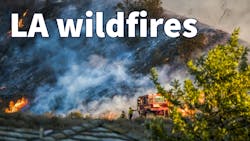How Southern California transformed into a ‘tinderbox’
More fire coverage across U.S. markets
Several other industries across Waterworld's parent brand, Endeavor Business Media, have reported on the fires around Los Angeles. Follow the links below to learn more.
-
Fire Dozer Clears Path of Abandoned Cars in L.A. Fires | Construction Equipment
-
Pasadena, CA, Firefighter Loses Own Home to Wildfire | Firehouse
-
Out-of-State Fire Trucks Headed to CA Wildfires Not Getting Emissions Tests | Firehouse
-
Fire Protection Measures Saved House in Pacific Palisades, CA | Firehouse
-
Wet periods, dry periods, strong winds and wildfires are all things that Californians are accustomed to. When these ingredients are combined simultaneously, the perfect storm is created.
Strong winds and historical weather patterns provided the perfect conditions for the wildfires.
Speculative comments surrounding water shortages and the inability to fight the fires fueled controversy.
Understanding the fires
In order to understand what exactly happened in California, it is best to take a step back to look at the big picture.
While the fires may have broken out on January 7, 2025, with the Palisades fire, the fuel for the raging fires was years in the making.
Dr. Mark Gold witnessed the fires firsthand. He is currently the director for water scarcity solutions and environmental health at the Natural Resources Defense Council.
“We’ve had 0.16 inches of rain since May 5 of last year,” Dr. Gold said. “It’s the second driest period from May to January in 150 years in California.”
Dr. Gold is based in Santa Monica, where, in his words, he has focused on “all things wet.”
“Two and a half years ago we had one of the wettest years on record,” Dr. Gold said. “And then last year we had an above average year.”
Dr. Gold stated that the growth from the wet years was enormous. All that vegetation has desiccated over the last eight months due to the historic dry period.
“All of Southern California right now is a tinderbox,” Dr. Gold said.
The region also experienced the strongest Santa Anna winds in 15 years, according to Dr. Gold.
According to the University of California, Los Angeles (UCLA), where Dr. Gold has been an adjunct professor for more than 15 years, the Santa Anna winds are blustery, dry and warm winds that blow out of the desert through Southern California.
“What was unusual here was that we all got warned about it almost a week out,” Dr. Gold said. “Unfortunately, there wasn’t much in the way of ‘what are we supposed to do about it? Are we not supposed to use water? Are we not allowed to use our fireplaces?’ There was nothing related to what can you do to actually minimize the risk of starting a fire.”
The ingredients of dry vegetation, strong winds and a lack of informing the public on how to minimize risk all compounded into the start of the Palisades fire.
Why were the fires hard to contain?
The Palisades fire broke out on Tuesday, January 7, 2025. The fire was intense.
Then the wind picked up.
“We’ve had gusts of 60 to 100 mph winds,” Dr. Gold said, “and constant winds in the 30 to 40 mph range.”
The strong winds enable the fuel and spread of the fire, but they also inhibit the containment of the fire.
One of California’s largest tools for fighting fires is tackling them from the air.
“As you can imagine, with the winds that extreme, night coming on, and the black smoke from all the buildings that were burning, what it meant was that all of the aerial firefighting equipment was grounded,” Dr. Gold said. “The firefighters, as brave as they are, trying to fight a fire like this with fire hydrants and hoses on it was just impossible.”
The inability to fight the fires from the air switched the focus to the ground.
We have the most water stored in our reservoir system in the history of the agency.
- Dr. Mark Gold
The water situation
“No system is designed where all your hydrants are on maximum water pressure and can maintain that pressure for 15-20 hours in a row – that’s not the design,” Dr. Gold said. “That’s what ended up happening here.”
There was early speculation that Southern California had run out of water.
“A: That’s not helpful and B: It’s completely ignorant,” Dr. Gold said. “This goes back to me sitting on the Metropolitan Water District (MWD) Board. If you don’t know MWD, we’re the largest public water wholesaler in the country. We have 19 million customers, so it’s basically all of Southern California’s population. We have the most water stored in our reservoir system in the history of the agency.”
Dr. Gold stated that the water was stored from California’s previous wet years.
“The conditions were beyond extraordinary and were beyond conditions that we’ve ever seen before,” Dr. Gold said. “And then on top of that the inadequacy of the infrastructure system to deal with fire in areas that have multiple square miles on fire in the urban area at the same time. How do we maintain water pressure high enough to keep that going when we don’t have any aerial support whatsoever on dousing those fires?”
Preparing for future scenarios
Dr. Gold stated that much more pumping capacity is needed to fight fires at this level. Smaller reservoirs are also needed in places that are potentially vulnerable to wildfires.
On top of this, these fires beg the question; ‘what areas are actually vulnerable to wildfires?’
“Our understanding of what was vulnerable was just wrong,” Dr. Gold said. “If you look at the Palisades and Altadena, the built commercial environment and the hundreds of houses adjacent to the downtown area, you just never would’ve thought that those areas were vulnerable.”
Municipalities that are prone to wildfires should reevaluate how much new infrastructure is needed to build wildfire resilience according to Dr. Gold.
On top of that, educating the public on how to prevent wildfires is key.
“The most important thing is don’t let those fires start,” Dr. Gold said.
About the Author
Alex Cossin
Associate Editor
Alex Cossin is the associate editor for Waterworld Magazine, Wastewater Digest and Stormwater Solutions, which compose the Endeavor Business Media Water Group. Cossin graduated from Kent State University in 2018 with a Bachelor of Science in Journalism. Cossin can be reached at [email protected].

